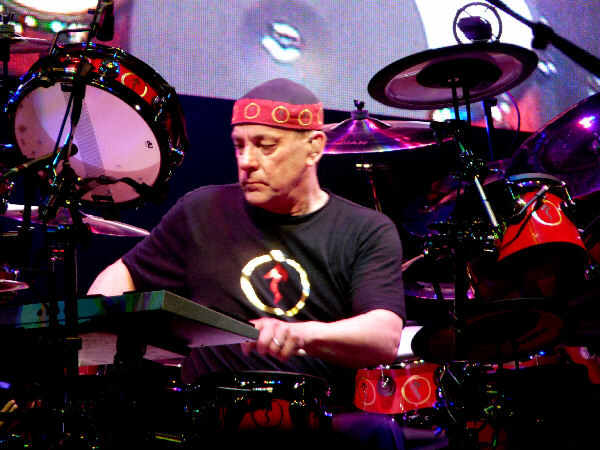 This Is Not A
BLOG!
This Is Not A
BLOG!
Date: 11/01/20
"Experience Slips Away..."

Neil Ellwood Peart
Musician, lyricist, author
b. 12 September 1952, d. 7 January 2020
To describe Neil Peart as 'a drummer' would be roughly akin to describing Michelangelo as 'a decorator'. For - unlike many bashers in rock and pop - he regarded drums and percussion as being fully capable of giving expression to moods and ambience beyond the merely dynamic. As a result, he spent nearly his whole career of close on fifty years being regarded - rightly - as one of the (as it were) Premier exponents of the drummer's art in any genre (although I don't believe he ever used Premier drums; I'm afraid that the pun was too strong to resist).
His distinctiveness meant that, when he joined his fellow Canucks Geddy Lee and Alex Lifeson in Rush in 1974, it changed the whole complexion of the group. Not only was his contribution to the music a huge step forward from the derivative incipient cock-rock evident on the debut LP they had made with original drummer John Rutsey (where Lee's obviously fervent wish to emulate Robert Plant is often painful to listen to), but - unusually - he soon became the band's main lyricist as well.
Even more unusually, those lyrics displayed a depth of thought and erudition generally thought to be beyond drummers qua drummers, let alone as writers. Peart's main ideological inspiration was the appalling Ayn Rand, and many of his early lyrics reflect a 'libertarian'/objectivist point of view. There was nothing strident about them, however; he was too intelligent and gentle-natured to go in for anything which could be construed as proselytising, preferring instead just to express his feelings simply, but often to great poetic effect. He was never dogmatic about any of it, and was willing to resile more than somewhat from the Randian world-view in later years.
The subject-matter of the lyrics was far wider than the preceding paragraph may suggest: the sublime Madrigal (from 1977's A Farewell To Kings) is one of the most beautiful love songs in the whole rock canon...hang on; cop a load of it and hear what I mean:

Where was I? Oh yeah. Jacob's Ladder (Permanent Waves (1980) is a combination of complex and varying time signatures allied with a cinematic ambience:

Peart's political philosophy came out again most memorably in the classic Subdivisions from the album Signals (1982), in which he describes growing up in suburban Ontario, where young people's wish to be themselves was stifled by a culture in which you had to - as the lyrics put it - "conform or be cast out".

(That's Peart's voice you hear saying, "Subdivisions" in the choruses, by the way; Lifeson mimes it in the video)
The band's output now being more keyboards-based than before, 1984's Grace Under Pressure gave us Red Sector A, with lyrics based on the story of Lee's mother's liberation from Bergen-Belsen concentration camp. The clip I've chosen displays the lyrics because it's more important that you understand them. As someone put it, they tell of"...future events in the past tense.":

Finally, from 1988's Hold Your Fire comes a track I've talked about before, but I'll link to it again here for completeness' sake:

Rush was to continue for another twenty years, with one major break between 1997 and 2001. This was because Neil Peart lost his teenaged daughter (to a road accident) and his wife (to illness) within less than a year. He then went on what amounted to the road trip to end all road trips across the continent on his BMW bike (about which he was to write the book Ghost Rider, one of a number of non-fiction and fiction works which he produced in the last twenty years of his life), before rejoining Rush with both he and the band re-invigorated.
It would be right to end with an example of the man up there on his own in concert. Although Peart's solos traditionally appeared within other tracks, latterly he had had his own spot during live sets to display his talent (and show off how many items of hardware featured in his kit).
(I know, I know; 'drum solo' is a phrase as feared in the lexicon of rock music as the phrase 'difficult second album', and with good reason. They seldom turn out well, and all too often detract from everthing else either side of them; for example, there's one by Pierre van der Linden on side 4 of Focus' 1972 offering Focus 3 which is over four minutes long and would have outstayed its welcome had it been a quarter that size. After that point, listening to it is like being constantly belted behind the right ear with a sockful of over-ripe Gouda.)
Bear with me on this one. For not only did Peart have a massive kit (arranged in a circle which almost meant that he had to be lowered into it), but he knew how to play every part of it to its full advantage, as befits a man who was still taking drum lessons in his early sixties.
In the clip that follows, he hits everything bar the kitchen sink (which had to pull out due to a scheduling problem; a couple of washing machines did turn up for the gig however, and they can be glimpsed occasionally stage left). But he hits them with such technique, with such understanding of their capabilities and with such verve that he manages to pull the drum solo out from its position of justified obliquy and odium. And there's a little suprise at the end to remind us that he had played with Buddy Rich's Big Band (after that notoriously short-tempered virtuoso was safely dead, however).
Watch, listen and marvel.








 This Is Not A
BLOG!
This Is Not A
BLOG!











